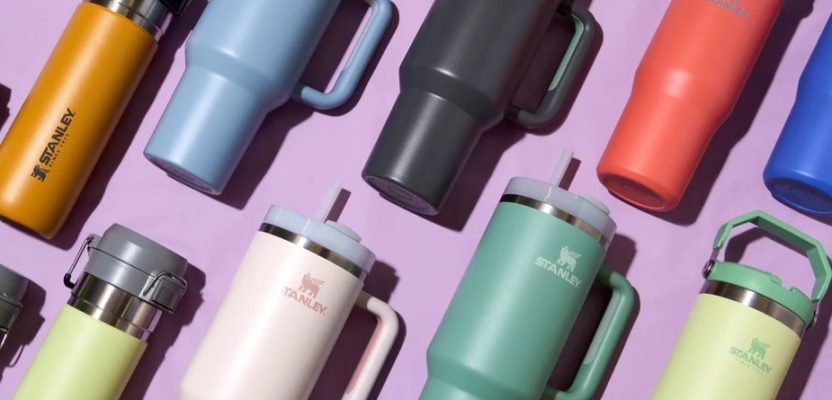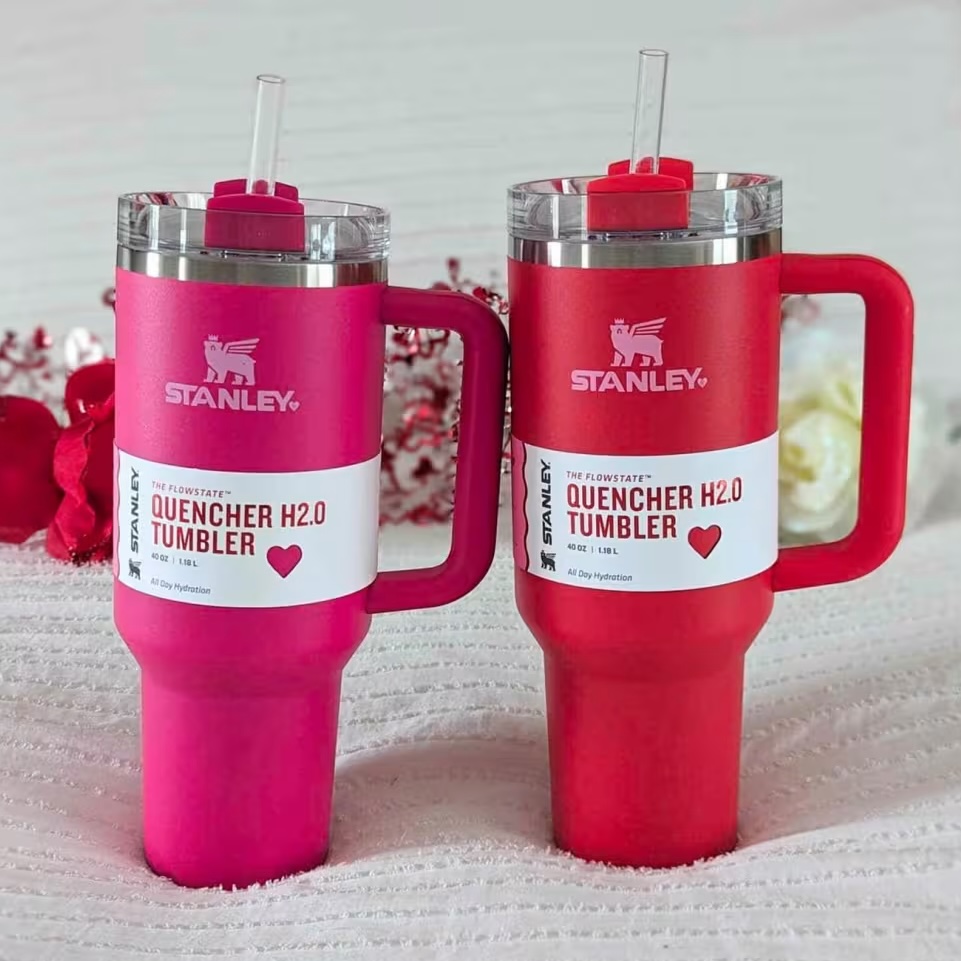In case you’ve missed it: the Stanley water bottle is having a cultural moment. It’s almost impossible to get online without seeing the Quencher H2.0 on your feed: pastel-coloured and possibly nestled in a matching carry case. The hashtag #StanleyCup has billions of views on TikTok (the Evening Standard credit this partially to the popularity of #watertok). Within the #StanleyCup hashtag you’ll find videos of Gen Z influencers showing how they pack their Stanley for the gym or for class; consumers left bruised after scrambling to add a new colour or limited edition release to their collection; and tweenage girls in tears after unwrapping their very own Stanley at Christmas. Olivia Rodrigo referred to the trend as a ‘subculture’ in a video with GQ, where she showed off her own Stanley (it’s purple, of course).
This isn’t the first time we’ve seen a water bottle break the internet: HydroJugs gained enough popularity that there are dedicated Reddit threads hating on girls who collect them, and the popularity of Nalgene bottles earned them numerous brand collaborations, with these bottles still remaining popular with fans of the gorpcore aesthetic.



The common theme here is not the water bottles themselves, but rather the fact they each represent a certain aesthetic. A Stanley cup holds two functions: it helps you stay hydrated, and it also communicates something about you to the world – serving as a kind of shorthand introduction. In this sense, the Stanley cup is a case study in successful branding.
Examining the trend
To unpack this trend further, Phil Edwards, a YouTuber and ‘edutainer’ recently shared a video where he employed the wisdom of the 19th century economist Thorstein Veblen to understand the Stanley trend.
Edwards starts by looking at the origins of the Stanley cup, which was patented in 1912 and became famous for its durability. Today, the cups are famous for a different reason: because they are a trending item that have, in Edwards’ words, ‘taken over the world’. He outlines three reasons that might have contributed to the Stanley cup fame:
- Viral moments
One of these moments included a video shared by a woman whose car blew up. Her Stanley cup, however, was unharmed: the ice in her drink hadn’t even melted. Terrance Riley (Marketing Head at Stanley) responded to her video, saying: ‘We’ve never done this before, and we’ll probably never do this again, but we’d love to replace your vehicle.’ - Influencers
The Buy Guide shared the Stanley cup just as this trend was emerging. Of course, now myriad influences are helping to sustain it. - Social media
Edwards says that ‘social media’ is often cited as a big factor, but vaguely. Nobody seems to really understand it, or be able to explain it.
Here, Edwards turns to Thorstein Veblen to offer an alternative explanation. Veblen, an American economist who is a well-known critic of capitalism, published his book Theory of the Leisure Class in 1899. The text explores a social group that emerged during the Industrial Revolution: a class of people that were not royalty, but not workers either: ‘doctors, factory owners, and accountants’.
Veblen coined the phrase ‘conspicuous consumption’ to explain the purchase habits of the leisure class, giving the example that someone who belongs to this group would likely choose to purchase a beautiful wrought silver spoon rather than a plain machine-made spoon. Although both serve the same function, only one possesses aesthetic beauty.
Edwards posits that the concept of conspicuous consumption can be used to explain the reason that so many of us are choosing a Stanley water bottle over the available alternatives.
The Terrance Riley effect
Next, Edwards examines the career of Terrance Riley, Stanley’s Marketing Head, in order to further explain the trend. Riley previously held the position of CMO at Crocs, where he resurrected a brand that had been almost forgotten. Riley employed tactics from sneaker drop culture: generating artificial scarcity and a sense of exclusivity by collaborating with brands to create limited edition Crocs products.
Marketing collateral that featured recognisable celebrities or popular brand names meant that Crocs was able to reach new audiences. At Novagram, we also understand just how important this is to our clients. We are able to create powerful marketing materials that can help you connect with your target audiences.
Lil Nas X for Crocs
Lazy Oaf x Crocs
Perhaps initially, people weren’t purchasing the new products because they loved Crocs, but rather because they loved Post Malone, Lil Nas X, or even KFC. These limited edition collaborations were marketed towards a wide range of consumers, spanning a huge spectrum of demographics. Liberty and Lazy Oaf, for example, are two fashion brands that cater to very different clientele – and yet, Crocs partnered with both brands.
As a result of these strategic collaborations, we began to see Crocs everywhere – until suddenly, Crocs were in again. Like a Trojan horse with your favourite celebrity’s face, Crocs had infiltrated the inner circle of pop culture.
Having proved that sneaker drop culture could be mapped onto Crocs’ marketing strategy, Riley was able to apply the same principle to Stanley cups. Stanley collaborated with Starbucks, Target, Peter Perch, and Lainey Wilson: each time generating artificial scarcity through extremely limited drops.
Stanley’s limited edition Valentine's cup
Lainey Wilson x Stanley
Breaking new ground
It is clear that expanding Stanley’s audience has been a key ingredient in the brand’s success.
Even though Stanley cups were originally marketed towards men, it’s primarily girls and women that are engaging with the current trend. Expanding to include a wider target audience has allowed the Stanley cup to become more than a cup: it’s a trending fashion item. So, with products that now far exceed the scope of their original function, what kind of brand is Stanley now? German-American economist and professor Theodore Levitt can help us find an answer. In an essay entitled ‘Marketing Myopia’, Levitt wrote:
‘What business are you really in? A seemingly obvious question – but one we should all ask before demand for our companies’ products or services dwindle. The railroads failed to ask this same question – and stopped growing. Why? Not because people no longer needed transportation. And not because other innovations (cars, airplanes) filled transportation needs. Rather, railroads stopped growing because railroads didn’t move to fill those needs. Their executives incorrectly thought that they were in the railroad business, not the transportation business.’
Stanley, having realised its potential to appeal to a wider audience, has now reached the status of a lifestyle brand. Stanley does not just sell cups, it sells identity.
If your organisation is looking to expand its audience or break new ground, Novagram can help. We have a proven track record of generating winning ideas for brands, helping them to grow and find success.
Thriving online
It’s also impossible not to notice one common theme in this discussion: the internet. Whether it’s dedicated Stanley cup collectors following the latest releases on TikTok, or Crocs popping up all over celebrities’ Instagram feeds, the primary way that people are engaging with new products is online.
This means that, for a brand like Stanley, digital presence is incredibly important: its website needs to be user-friendly, on-brand, and able to handle high amounts of traffic. Websites are also an effective way for brands to showcase new products or ideas. We are able to help our clients do this, and have built websites for brands from a range of industries.
What we’ve learned
It’s clear that Stanley’s success is down to more than chance. This is not just a social-media-fueled fluke: it’s the result of a calculated and well executed strategy.A perfect storm of technology and human nature in action, the Stanley trend demonstrates exactly what it takes for brands to succeed today. To truly understand branding and marketing, we must understand what motivates and drives human behaviour. To succeed, you’ll also need great ideas, strong marketing collateral, and an optimised digital presence. All of this will allow you to find your audience, and make that connection.










